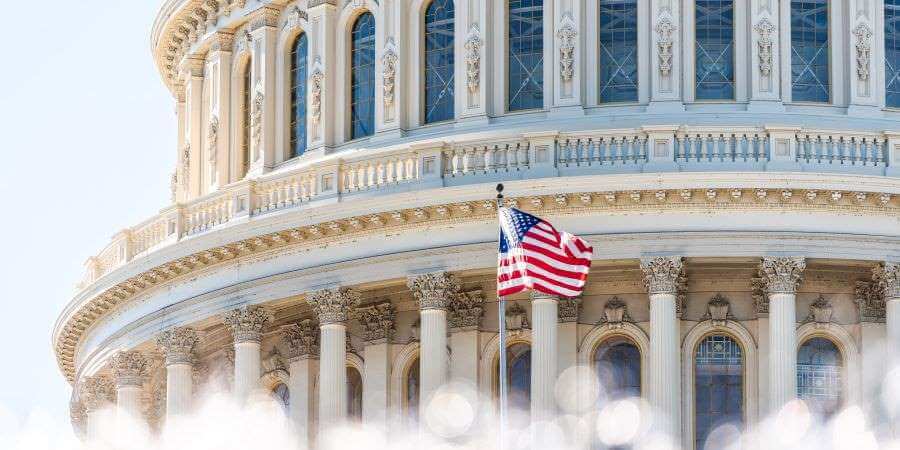by Kristina Hooper, Chief Global Strategist, Invesco Canada
Stocks march upward during a tumultuous week in U.S. history
Weekly Market Compass: It was a week of surprise, horror and disappointment. Why didn’t stocks react?
The past week has been a momentous one, to say the least. It was filled with surprise, horror and disappointment — certainly in the U.S., but also for those watching around the world. I received a number of questions about how the stock market could be up in a week like this one. Let me try to explain:
We have to recognize that the stock market has had an upward bias that was created long before the November election, driven by strong monetary policy accommodation from the U.S. Federal Reserve. Then we learned in the fourth quarter that multiple vaccines had been developed that were effective in protecting against COVID-19. That is a gamechanger and creates a lot more confidence in an economic recovery in 2021, which in turn is obviously a powerful catalyst for stocks. And so, I believe stocks looked at events and data this week through the lens of positive bias.
Surprise
First came the Georgia Senate elections on Jan. 5. The Democratic sweep came as a surprise to so many; it is certainly not what we would have predicted in November. Our early election analysis focused on what investors might expect from a divided government. Now, we turn our sights to what’s possible under a unified government led by the Democrats.
Clients have asked how the stock market can rally with a unified Democratic government, especially since the stock market typically rewards divided governments. While divided government has typically appealed to markets, I would argue that it’s perhaps better to have a unified government in a time of crisis – which I believe markets are recognizing. The U.S. is facing a massive health and economic crisis, and so the ability to get nominees confirmed and to legislate is important. But keep in mind this is a razor-thin margin, which is likely to ensure most legislation is in the “center lane” for America.
My colleague Andy Blocker, Head of US Government Affairs for Invesco, provided a list of two categories: things that are “now possible” and “not possible” given the Senate results.
Now possible
- Once inaugurated, President-elect Biden should be able to get his full Cabinet confirmed in a timely fashion.
- A second round of COVID-19 relief and assistance is widely expected to be larger and contain state and local assistance.
- A robust infrastructure package is now more possible and will likely include green initiatives.
- Tax increases to help pay for infrastructure are now possible starting with corporate taxes, with a chance for other targeted tax increases.
Still not possible
- The Senate filibuster will stay in place. Senator Joe Manchin has already stated that he will not vote to get rid of the filibuster for legislative items.
- Keeping the filibuster prevents “packing” the Supreme Court (increasing the number of seats on the court and filling them with Biden nominees) and prevents statehood for the District of Columbia or Puerto Rico.
- We don’t expect a Green New Deal, even though there may be attempts to intersperse green initiatives in various bills as they are considered.
- We also don’t expect Medicare for All. President-elect Biden does not support it, and even if he did, there are not the votes among Democrats in the Senate to pass it, in our view.
Horror
As the U.S. was learning the election results, then came the heinous and violent takeover of the U.S. Capitol. Despite such a destabilizing attack on American democracy, markets barely flinched. But why not?
I believe stocks were looking ahead to better days, expecting a robust economic recovery once there is broad distribution of vaccines – and anticipating more stimulus given the outcome of the Georgia Senate races. As my colleague Brian Levitt aptly put it, “I take solace in the system holding, democracy prevailing, and the markets focusing on persistent tailwinds.” I couldn’t agree more.
Disappointment
And then finally, on Friday, we got the U.S. jobs reports for December, which showed a decline in monthly payrolls for the first time since the recovery started. It reminded us of the terrible impact of rising COVID-19 infections, which can easily derail a nascent recovery. I was not surprised by this report. The U.S. has allowed the economy to be damaged by withholding stimulus for so long. I believe the K-shaped recovery1 is going to get worse before it gets better – but it should get better later in 2021.
If markets were surprised by the jobs report, they didn’t show it. In fact, stocks reacted positively, as it adds to the potential for more stimulus.
Later in the day on Friday, we learned that Senator Manchin opposes an additional $2,000 stimulus check, and that briefly pushed stocks lower before an aide walked the comments back and stocks breathed a sigh of relief. As I have said before, the current environment necessitates ongoing fiscal stimulus until vaccines are broadly distributed and the economy can fully re-open. I expect that to happen.
Key takeaway
In terms of market implications from this week, the key takeaway, in my view, is that the reflation trade1 should continue because markets expect a strong recovery this year after some early headwinds. I believe the recovery is now likely to have additional support behind it given the election outcome this week, which I would expect to benefit cyclical and smaller-cap stocks. Cyclical momentum should also help drive the 10-year U.S. Treasury yield modestly higher, although we continue to expect modest inflation.
As we have seen time and time again, even horror and disappointment can be overlooked by markets when monetary conditions are supportive. And that is certainly true of 2021 so far.
This post was first published at the official blog of Invesco Canada.














